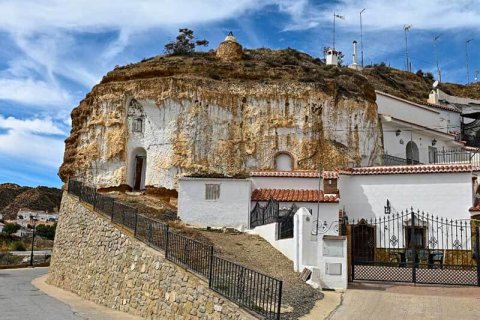
Common people have already forgotten the images of the inhabitants of the cave houses of Andalusia. They posed with mistrustful looks and tired eyes for a photographer, as if they were a species on the edge of extinction.
The images of Spanish gypsies living in the “cave quarter” of Sacromonte, close to Granada, have been forgotten too. They made a living by dancing and entertaining post-war tourists, such as Hollywood stars Anthony Quinn and Ingrid Bergman.
Today, cave houses throughout Andalusia are not even close to the clichés of poor, "antediluvian" accommodation for the poor. Today, these bizarre homes are gaining popularity among buyers who search for the unique comfort of 21st century housing.
One of the undeniable advantages of this "accommodation of the 21st century" is the ability to maintain a stable temperature regime within the range of 18-22 degrees.
The ability to keep this stable temperature throughout the year without the need for special additional actions immediately puts these houses in a specific category of comfort in the context of the current global energy crisis. Cave houses do not need heating or special air conditioning.
They started their own history in the 15th century, shortly before the Granada War, as emergency hideouts for the Moors seeking shelter from the military actions. Today, the cave houses are regulated by the "Law on the Promotion of Territorial Sustainability of Andalucía".
Centuries later, cave houses continue to exist in different regions of Andalusia:
- In the cities of Cuevas del Almansora and Canjáyar in Almeria province;
- In the cities of Arcos de la Frontera or Setenil de las Bodegas in the province of Cádiz;
- They are most common in the province of Granada.
During the census and inventory of the housing stock of the cave homes carried out by the executive local authorities of Granada, 20,252 units were identified. They are located in 27 cities in the Guadix, Baza, and Huescar districts. Except those which are located in the Sacromonte area, close to Granada, the provincial capital.
42% of the objects were in good condition, and all the rest were in poor condition, satisfactory condition, or completely destroyed. The new legislation reveals the fog of law on the way of housing development in the future.
Earthquake shelter
Carved out of the rock, the cave house offers exceptionally good shelter from various natural disasters. At the same time, this cave does not have to be a musty, crowded room with a bunch of small rooms.
Luis Manuel Villalba, a husband and father of two daughters, lives in one of these houses. The residential unit covers an area of 200 square meters. It is located in the La Teja area of Guadix. His professional activities involve the renovation and major maintenance of such housing facilities.
He has already gone through six houses of this type. He is 33, and he is a perfect specialist in turning any modest cave into an object worthy of the front cover of a design magazine. Even his own house had previously been nothing more than a sheep pen.
Caves are a growing market sector
Francisco Rivera, president of the Andalusian Association of Cave Houses, specifies the recent legal uncertainty of such properties, and emphasizes: “From an urban studies’ point of view, they were not regulated at the government level at all.” Today, cave houses are registered in the Land Cadastre.
New legislation
Until quite recently, houses in caves were not intended to be addressed as legitimate housing in any urban planning regulations. The situation was resolved only by LIST, a new legislative code where Section IX includes 12 articles dedicated specifically to cave houses.
Under the new legislation, such houses are defined as “housing in a cave” or “a cave dwelling” (note. Troglodytic Habitat). A cave house is a living space that was created through the occupation and settlement of the earth's subsurface in a certain geographical area with the use of natural cave formations.
A cave house is different than a house connected to a cave. It is defined as a structure connected to wild terrain that is less than 50% of the house's living area. The concept of "a cave area" is introduced separately. It is the territory of urban land occupied by a complex of underground or cave dwellings.
The concept of a "cave municipality" or a "cave city" has also been introduced. It refers to settlements where more than 15% of existing residential units are cave properties or more than 50% of urban land consists of cave properties.
This municipality has special cultural, historical, and tourist importance. So, they are protected in a special order.
